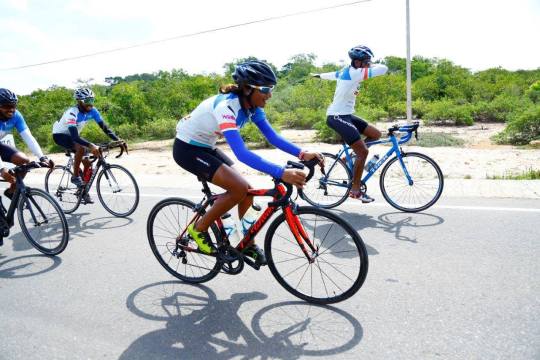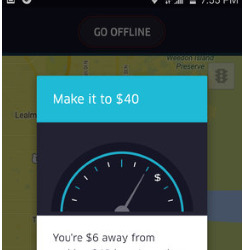Text
The pull of cultural norms
Reading this case struck a chord with me. I’m a British-born Sri Lankan and have grown up with predominantly British values. Whilst I was aware of fairness being an attractive quality (particularly for South Asians), this thinking was balanced by my English classmates each summer gushing over their holiday tans. As an athlete, sun and tanning was inevitable so I was largely unaffected by these cultural norms growing up.
Rather, it was only when I married and moved to Sri Lanka for a few years that I truly appreciated how suffocating such norms can be. It’s easy enough to think you should know your own mind, however, even as someone very stable in my own values; constant reminders to wear a hat, or disapproving looks at a day spent riding in the sun, or getting married with a very noticeable tan after holidaying on the Great Barrier Reef certainly did get to me.

Tanning under the scorching sun in Sri Lanka on a two-week ride around the country
Fortunately, a strong husband and the conviction in my own mind prevented these comments affecting my behavior. I was fortunate to create my friendships among other outdoorsy people and those that had spent time in other cultures. It was only at events - weddings, conferences, dinners and such - that occasionally I would be exposed to those comments.
However, for those without such readily accessible outlets, I can only imagine how difficult it is to continue to be confident in who you are when everyone around you has been conditioned to think differently. It’s perhaps only celebrities on TV and big brands that can serve as the main escape into a wider world of thinking. Its therefore very sad when brands and celebrities prioritize profits, forgetting the damaging impact their actions have on consumers.
I saw many things wrong with Hindustan Unilever and Emami’s product line -
Reinforcement of harmful cultural norms
Depiction of those without these ‘desirable’ traits in a negative light
Use of disingenuous celebrity endorsements
Questionable product performance
Use of harmful ingredients
Brands have a huge responsibility not to play into these stereotypes. It was wonderful to see Dove adverts by contrast showing that a woman should embrace her own beauty, and campaigns such as Dark is Beautiful working to change this conditioning. One hopes that other brands can follow suit.
youtube
Dove’s Let’s Break The Rules of Beauty Campaign
0 notes
Text
Building on Rogers’ Five Factors
Everett Rogers hypothesized that five factors influence individuals in their adoption of new innovation: (1) relative advantage; (2) trialability; (3) complexity; (4) compatibility; and, (5) observability.

Under the Diffusions of Innovation theory, technology is adopted at a pace that can be graphed as a normal distribution, along which different types of adopters take up the innovation sequentially.
Since this original theory was posited, there have been additional evolutions to this framework that should also form a substantive analysis of “new-to-the-world” product adoption -
1. The Technology S-curve (Foster, 1986, Christensen 1997)
2. Crossing the Chasm (Geoffrey Moore, 1991)
The Technology S-curve
This take-up path translates into an “S” form when graphed against time. As early take-up accelerates, then reaches market saturation, and finally obsolescence. Further, it was noted that these S-curves were attached in a series of waves i.e. where newer s-curves represent superior innovations and therefore indicate a window of viability/opportunity with which the existing curve can generate value.

Crossing the Chasm
The idea that technological innovations can receive significant traction among early adopters, however, in many cases, are not adopted more broadly by the market. This ‘chasm’ between early adopters and majority adopters exists because of different psychographic profiles between these two groups (and therefore very different drivers of adoption). Each adopter group weighs each of Rogers’ Five Factors differently and hence early traction may not transfer to later adopter groups.

0 notes
Text
The ethical line in nudging
Whilst reading about nudge theory these past couple of classes, its been interesting to also reflect on the ethical implications of using nudging to increase sales. Common examples that come to mind are “last 2 seats” or “last available rooms” banners in the travel & hospitality space (for flights and hotels). Interestingly searching on booking.com, where hotels must surely be struggling with COVID-19 still forcing millions to stay home, the site continues to portray an image of peak demand holiday season.

Source: booking.com search result
Whilst its very possible that the exact wording of “at this price” or “on this site” might make these scarcity statements accurate, it raises the concern that these nudges may in fact move a consumer away from their optimal decision in rushing the booking process and failing to conduct their full search.
Whilst businesses and marketers spend considerable time understanding the product selection process, consumers will spend just a few minutes. And as we saw in this week’s reading, simple things like framing (placing higher and lower priced options around a target product) can direct a customer to a particular sale.
Looking into this “darker side” of nudging, I came across a NYT article on what can happen when a company’s incentives are misaligned with - in this case their drivers. Uber generates more business by reducing wait times for its customers. However, reducing wait times for customers is achieved by having more drivers on the road - and specifically - having more drivers idling.
In responding to these incentives, Uber have employed tactics that encourage drivers to stay on the road -
prompting an additional ride to meet an arbitrary income target e.g. “You’re $10 away from making $330 in net earnings. Are you sure you want to go offline?”
adopting a female persona for engaging with drivers - increases engagement with an overwhelmingly male driver population
gamifying the app experience, rewarding drivers with badges rather than monetary rewards
In instances where drivers aren’t making more money by staying on the road longer and thereby subvert the original/optimal choice, these tactics have ethical implications that are important to also consider.

2 notes
·
View notes
Text
Building a Brand Ritual is Key to Lasting Brand Engagement
“Beer is all marketing. People don’t drink beer, they drink marketing.”
Corona beer stands out in a crowded market for its association with a ritual of squeezing a lime into the drink before consuming. Whilst this habitual action now features heavily in Corona’s advertising, it was interesting that this ritual was in fact derived from consumer behavior – it was consumers that started adding lime to the drink and Corona was able to capitalize on this to great effect.

Creating a brand ritual requires two considerations -
1. How do a large segment of people consume the product?
2. Does this action add value to the product?
Combining a simple, habitual action loved by the majority of your consumers, with value addition (e.g. improvement in taste, sense of belonging) creates an effective brand ritual. Rituals convey added value and importance and thereby give customers a compelling reason to choose the brand in a crowded marketplace.
One of the most iconic brand rituals is Oreo’s – twist, lick, dunk ritual. Without it, the Oreo is just another sandwich cookie, but with it, the product stands apart. The ritual is simple - so much so that children can learn it (children are often featured performing the ritual in marketing campaigns) and the ritual serves to evoke childhood memories that creates strong attachment.

2 notes
·
View notes
Text
Product differentiation amongst end-user segments
Despite a quality product, B&D are unable to gain traction in the tradesman/professional users segment. The core reason behind this is a lack of product differentiation amongst end-user segments – specifically between the Consumer segment tools vs. the Professional segment tools. An important differentiating factor between power tools is color. B&D use black for consumer-grade tools vs. a charcoal grey for professional-grade tools. Competitors have a clearer color differentiation. Furthermore, B&D’s brand dominance in the consumer segment has a negative impact on tradesman sales – since consumers often hire tradesman for work where they believe a ‘professional is required’ they may look to the professional’s tools as a sign of competency and value in what they are paying for. Confronted with a tradesman that works with what appears to be the same consumer-grade tools that you have at home is likely to make a negative impression on the consumer.
In addition to perceptions on the job, tradesmen have also used consumer segment tools for professional jobs (where they were not intended for such use) and have had negative experiences with the brand as a result.
Ultimately the issue is one of a lack of product differentiation between end-user segments. Without adequate differentiation, use of consumer-grade tools and perception on the job are negative for the tradesmen relationship with B&D. Given there is no underlying quality rationale for B&D underperforming in the tradesman segment, the strategy should be to push for this differentiation and build share. Whilst an entire branding change may be to extreme, a sub-branding strategy accompanied by a new color for tradesman tools could be a way forward.
1 note
·
View note